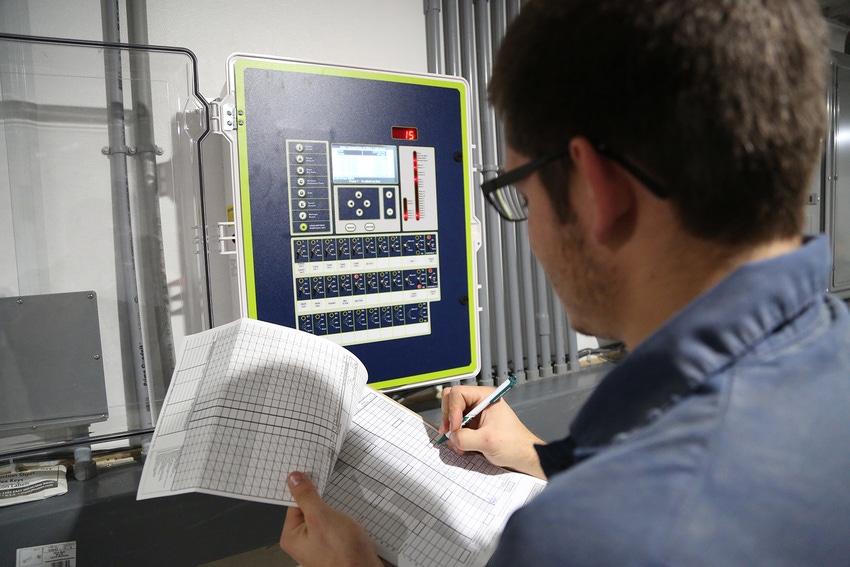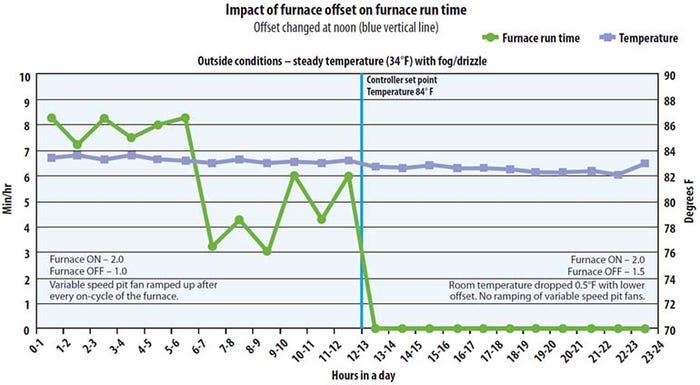When looking for strategies to reduce fuel consumption, pay attention to detail, including observation of heater run time, routine maintenance and verifying controlling settings.
November 21, 2018

By Brett C. Ramirez, Jay D. Harmon, and Steven J. Hoff, Iowa State University Department of Agricultural and Biosystems Engineering
A while back, some strategies to reduce electrical energy usage were discussed and mainly focused on the various aspects that can degrade fan efficiency. This column will shift its focus toward heaters and their settings to reduce LP usage. An understanding of the ventilation system and potential impact on the pigs is needed to determine the best strategies for balancing indoor environment and production costs.
A facility needs to provide the optimum environmental conditions to maximize production efficiency while conserving energy. If both these goals are accomplished, the result can be reduced operating costs for the producer. However, a “complete” ventilation system that is designed, installed and managed for the specific animals, climate and needs of the producer. Beyond design and equipment selection (such as fans, air inlets and heaters), excellent management and operation are also equally crucial. While today’s controllers automate much of the process, it is still important for facility managers to understand the ventilation process basics and where adjustments can be made to maximize effectiveness.
Generally, forced air furnaces are non-vented, gas-fired units that are sized to supply supplemental heat based off the heat loss through the building envelop, ventilation and heat produced by the pigs. Improper sizing can lead to excessive energy consumption and a non-uniform environment. Forced air furnaces, generate large bursts of hot air and can cause the room to heat up to the point at which additional exhaust fans activate to cool the room due to exceeding the controller setpoint. This is typically caused by slow feedback sensor response time (i.e., controller does not sense the rapid temperature increase), poor placement of the sensor and improper control settings. Further, since additional fans are operating, the room temperature decreases, and the forced air furnaces are again activated, and the cycle continues, wasting propane and causing large temperature swings. The “overshoot” of the desired room temperature by oversized heaters can be mitigated by replacing them with smaller heaters or by adjusting the heater to reduce the output to about 60% of its maximum output.
Gas-fired equipment requires careful and routine maintenance to ensure the equipment is operating at its manufactured efficiency. This involves inspecting and cleaning the orifice regulating gas flow. If the orifice is damaged from improper cleaning methods, it can be enlarged and result in incomplete combustion; thus, wasting gas and creating additional carbon monoxide.
A brief understanding of controller terminology is needed prior to implementing any strategy. The first key parameter is the set point temperature or desired room temperature. This is essentially the temperature setting at which the pigs can be thermally comfortable. The set point decreases as the pigs grow as result on the increased metabolic heat production (i.e., more heat needs to be removed; hence, a lower temperature). It should be noted that the set point is not the average temperature but often distinguished as the temperature that separates heating and cooling (where cooling is increased ventilation rate). Typically, the actual room temperature will be below setpoint in winter (during heating cycles) and above setpoint during summer. Heaters also use an “on” and “off” temperature or differential (temperature between heater on and off; i.e., “off” — “on” temperature). Further, an offset is used to identify the number of degrees below the set point that the heater will turn off. Heater “off” temperature is typically set to 1.5 F to 2 F below the set point. If the heater turns off too close to the set point, temperature will continue to rise beyond the set point, and minimum ventilation will increase speed (or next stage will come on).

The left side of the graph shows the furnace run time when it was set to come on 2 F below set point and turn off at 1 F below. The right side shows the furnace stopped running when the off temperature was changed from 1 F below to 1.5 F below SP. This resulted in a savings of 3.75 gallons of fuel per furnace per day. In this case, a small increase in the temperature difference between the SP and when the heater turns off prevented the cycling and reduced fuel usage significantly.
What does this mean? The heater just used all this fuel to heat the room and before that heat could fully distribute the fans ramped up to remove that heat, because room temperature went high enough to demand cooling. This can cause an incredible waste of energy. An easy way to diagnose an offset that is too small is to listen. A minimum ventilation fan should never increase speed soon after a heater turns off. If it does, increase the offset.
Heater size, maintenance and settings have a substantial impact on energy usage. So, when looking for strategies to reduce fuel consumption, pay attention to detail. This includes observation of heater run time, routine maintenance and verifying controlling settings. Click here to access “Managing swine ventilation controller settings to save energy” for more details.
You May Also Like



